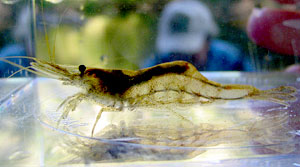 This year the federal Endangered Species Act (ESA) will celebrate its 35th anniversary. Under the ESA over 1,350 species are listed in the United States as threatened or endangered, including over 300 in California. This includes a number of "celebrities" of the conservation world such as the humpback whale and California condor, but also dozens of much more low profile species. Around our offices, we have a particular soft spot for the California freshwater shrimp (Syncaris pacifica), the impetus for our Students and Teachers Restoring a Watershed (STRAW) Project).
This year the federal Endangered Species Act (ESA) will celebrate its 35th anniversary. Under the ESA over 1,350 species are listed in the United States as threatened or endangered, including over 300 in California. This includes a number of "celebrities" of the conservation world such as the humpback whale and California condor, but also dozens of much more low profile species. Around our offices, we have a particular soft spot for the California freshwater shrimp (Syncaris pacifica), the impetus for our Students and Teachers Restoring a Watershed (STRAW) Project).
The California freshwater shrimp is 10-legged crustacean in the family Atyidae.
Found only in a handful of Bay Area creeks, the shrimp is a detritus feeder that prefers glides (calm, slow-flowing sections of streams) with undercut banks, exposed roots, and overhanging vegetation. Adult females produce relatively few eggs-about 50-120-that stick to the mother's pleopods during winter incubation. The young measure about 6 millimeters and are released in late spring or early summer. They grow rapidly, reaching up to 2.5 inches as adults and ranging in color from translucent to rusty red.
The species' closest cousin, the Pasadena freshwater shrimp (Syncaris pasadenae), went extinct in the 1930s, leaving the California freshwater shrimp as the only representative of its genus. The California freshwater shrimp was listed under the ESA in 1988. Recently the U.S. Fish & Wildlife Service issued its 5-year review of the shrimp's status. The report concludes that the species is not ready for delisting, as it still faces many of the same threats as 20 years ago: loss of habit due to agricultural activities and development, water pollution, water diversions-even the construction of recreational summer dams for swimming and fishing.
But there is also good news in the report. At the time it was listed, the shrimp was known from 17 streams; it now has been found in 23. In one of these, the number of shrimp surveyed increased from 1,878 in 1991 to 4,407 in 2000. Many of the streams in which the shrimp is found have watershed management plans in place. And the report also acknowledged the ongoing work of STRAW to restore more than 50,000 linear feet of stream bank, creating new habitat for the shrimp-not to mention other native species.
